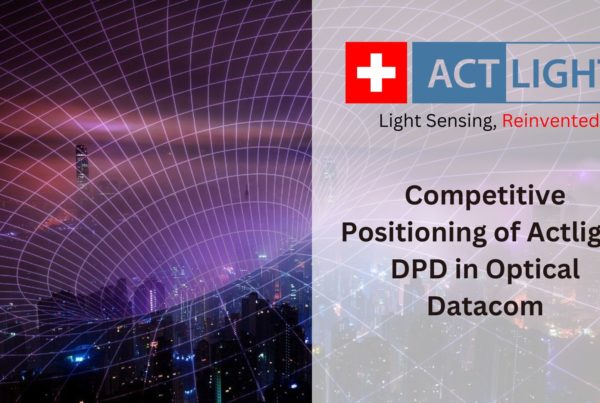As the wearable technology market rapidly evolves, sensor advancements in health monitoring and fitness tracking have led to devices like smartwatches and smart rings incorporating cutting-edge technologies such as Photoplethysmography (PPG), enabling increasingly accurate measurements of heart rate, and blood oxygen saturation (SpO2), pushing the boundaries of personalised healthcare and fitness management. In parallel, developments in smart glasses have introduced new possibilities, particularly in eye-tracking technology, fulfilling demands for hands-free augmented reality experiences. Strong IP strategies are crucial in this competitive landscape, fueling innovation, protecting groundbreaking developments, and enabling companies to scale confidently without the risk of infringement.
At ActLight, our Dynamic PhotoDetector (DPD), Front-End Electronics, Time to Digital Converter (TDC), and Pixel Design represent our commitment to pushing the boundaries of light-sensing technology. Our focus on maintaining robust IP protection ensures these innovations remain secure while driving significant progress in the wearable tech landscape and beyond.
Learn more about our IP on our technology page or reach out directly for a personalised pitch deck.
Wearable Tech Market Growth: An Expanding Horizon
With the wearable tech market projected to ship over 500 million units annually by 2025, according to IDC, devices like smartwatches, fitness trackers, and smart rings have become indispensable to consumers. These devices now offer advanced health monitoring features, but companies face growing challenges as they strive to innovate without infringing on existing patents. We see this happening in corporation which are pushing the boundaries of wearable technology, but innovation in areas like biometric sensors, data processing, and battery life is often constrained by existing IP protections held by competitors (Wurth, Navigating IP Challenges in the Wearable Tech Space, 2024).
Wearables may be just the start. We’re witnessing a rapid expansion into areas like AI and robotics, with Tesla’s humanoid robot exemplifying how sensor technology plays a role beyond wearables. For companies entering these next-gen industries, securing innovations with robust IP protection will be vital for staying competitive and safe-guarding new technological developments.
As many of you may be aware by now, Tesla recently held an event showcasing its humanoid robot, Optimus. This ambitious project, which aims to revolutionize industries from manufacturing to household assistance, was designed with a focus on AI and advanced sensor technology. Precise sensors like those in wearables are crucial for enabling these robots to interact with their surroundings effectively. Tesla’s demonstration highlights the growing role of sensors in AI-driven applications, emphasising the importance of cutting-edge innovation and strong IP protection in bringing such transformative technologies to market.
ActLight’s Technology and IP: Innovation Meets Protection
Our Dynamic PhotoDetector (DPD) is one of the key innovations that separates ActLight from traditional light-sensing technologies. Semiconductor photodiodes are the most widely used photodetectors in the electronics industry, playing a crucial role in applications ranging from ambient light sensors to high-bandwidth optical telecommunications systems. This technology dates back to the 1950s, marking decades of foundational use in a variety of advanced systems. Unlike conventional photodiodes, which rely on weak photocurrents, the DPD measures light intensity through delay times. This allows for:
- Greater precision and sensitivity: No external amplification needed, improving signal-to-noise ratio.
- Low power consumption: Essential for devices like smartwatches that require longer battery life.
- Compact integration: Has the possibility to fit into smaller devices like fitness trackers and smart rings seamlessly.
In combination with our innovations in Front-End Electronics and Time to Digital Converter (TDC), ActLight can achieve better data processing control while maintaining power efficiency, offering broad applications for wearables and beyond.
IP: The Key to Scaling Innovation
In a competitive landscape like wearable technology, having a solid IP foundation is crucial for long-term success. Companies that invest heavily in R&D must protect their breakthroughs through patents to prevent competitors from copying or building on their ideas. At ActLight, we own 100% of our patents, covering our advancements in DPD, TDC, pixel design, and imaging architectures. This protection allows us to confidently collaborate with industry leaders, ensuring that our technology remains both proprietary and scalable.
The Role of IP in Emerging Technologies
The push for miniaturisation and power efficiency in wearables has made sensor technologies and product development like ours essential. But it’s not just limited to wearables. We are now beginning to see growing interest in areas like AI-driven robotics, where sensing technology will be crucial. As more industries integrate advanced sensors, having a robust IP strategy is essential to securing a place in this competitive market.
As we push forward in the development of light-sensing technologies, we remain committed to ensuring our innovations are backed by a comprehensive and strong IP strategy, positioning us at the forefront of next-generation innovations.
For more insights on how ActLight patented technologies can help advance your innovations, visit our technology page or contact our CCO, Roberto Magnifico, for further discussion.






